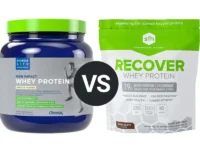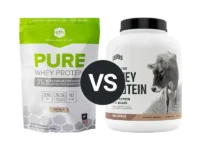Knowledge BaseYou're Questions Answered
BACK
What are artificial ingredients in protein powder?
Artificial ingredients in protein powder are substances that are added to the product to enhance its flavor, texture, or shelf life. These ingredients are typically chemically synthesized, and they may not be found naturally in food. Some examples of artificial ingredients that may be found in protein powder include:
- Artificial sweeteners: These are sugar substitutes that are added to protein powder to enhance its taste without adding calories. Some common artificial sweeteners used in protein powder include sucralose, aspartame, and acesulfame potassium.
- Artificial colors: These are synthetic dyes that are added to protein powder to enhance its appearance. Some common artificial colors used in protein powder include FD&C Yellow #5, FD&C Red #40, and FD&C Blue #1.
- Artificial flavors: These are chemical compounds that are added to protein powder to enhance its taste. Some common artificial flavors used in protein powder include vanillin, ethyl vanillin, and maltol.
- Preservatives: These are substances that are added to protein powder to prevent spoilage and increase its shelf life. Some common preservatives used in protein powder include sodium benzoate, potassium sorbate, and BHA (butylated hydroxyanisole).
While these ingredients are generally recognized as safe by regulatory agencies like the FDA, some people may prefer to avoid artificial ingredients for personal or health reasons. It's important to read the label and ingredient list carefully when choosing a protein powder and to consult with a healthcare professional or a registered dietitian if you have specific concerns.
Was this answer helpful? Let us know!
Like
References:
- US Food and Drug Administration. Guidance for Industry: Food Labeling Guide.
- Ludy MJ, Mattes RD. The effects of hedonically acceptable red pepper doses on thermogenesis and appetite. Physiol Behav. 2011;102(3-4):251-258.
- European Food Safety Authority. Food colors. EFSA J. 2009;7(10):1323.
- Sánchez-Otero MG, Bourges H, Rodríguez-Castellanos FE. The use of artificial sweeteners in the food industry: A review. Plant Foods Hum Nutr. 2020;75(3):387-394.
Add to this Answer
Your Answer
Do you have a suggestion to improve the answer? Please detail your suggestions and provide any references to information that may support your answer if available.
The content on this site has not been written, reviewed or endorsed by a medical professional. We assume no liability for the misuse of supplements and recommend you review the label of any product, as well as consulting with your health care professional.
We are a participant in the Amazon Services LLC Associates Program, an affiliate advertising program designed to provide a means for us to earn fees by linking to Amazon.com and affiliated sites.
We are a participant in the Amazon Services LLC Associates Program, an affiliate advertising program designed to provide a means for us to earn fees by linking to Amazon.com and affiliated sites.
© 2025 ProteinPowder.com


